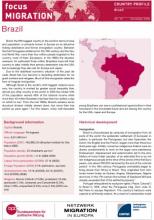
Brazil, the fifth biggest country in the world in terms of area and population, is primarily known in Europe as an attractive holiday destination and former immigration country. Between the first Portuguese settlement in the 16th century and the Second World War, more than four million people migrated to the country, most of them Europeans. In the 1980s the situation reversed. An estimated three million Brazilians have left their country to date; initially their primary destination was the USA, but increasingly they also aim for Europe and Japan.
Due to the stabilised economic situation1 of the past decade, Brazil has now become a rewarding destination for migrant workers and refugees. Much of this immigration takes the form of irregular immigration.
Although Brazil is the world’s ninth biggest national economy, the country is marked by greater social inequality than almost any other country in the world: in 2005 the richest 10% of the population earned 48% of the national income while more than 40 million Brazilians had less than two dollars a day on which to live.2 From the mid 1990s, Brazil’s extreme socio-structural division initially slowed down, but since then has picked up pace again.3 For this reason, many well-educated young Brazilians can see no professional opportunities in their homeland in the immediate future and are leaving the country for the USA, Japan and Europe.
[1] Since 2007 the rate of inflation has been 4.5 %. At the end of 2005 Brazil was in the position of being able to pay back prematurely its entire debt to the International Monetary Fund (IMF), which converts to USD 15.5 billion, thus depriving the IMF of its biggest borrower. (cf. New York Times, 02.06.2008).
[2] The Gini coefficient, used as a measure of inequality of income distribution, gave an index for Brazil in 2005 of 56.7, showing Brazil to be among the countries with the highest income inequalities worldwide. See Central Intelligence Agency (CIA): CIA World Factbook, https://www.cia.gov/library/publications/the-world-factbook/geos/br.html.
[3] See Arbix (2007).
| Attachment | Size |
|---|---|
| CP_15_brazil_01.pdf | 379.56 KB |
